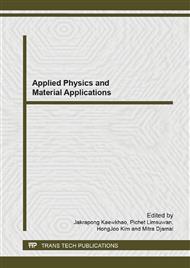[1]
E. Budke, J. Krempel-Hesse, H. Maidhof and H. Schüssler, Decorative hard coatings with improved corrosion resistance, Surf. Coat. Technol. 108 (1999) 108–113.
DOI: 10.1016/s0257-8972(98)00791-9
Google Scholar
[2]
H. Holleck, Material selection for hard coatings, J. Vac. Sci. Technol. 4 (1986) 2661-2670.
Google Scholar
[3]
L. Van Leavan, M.N. Alias and R. Brown, Corrosion behavior of ion plated and implated films, Surf. Coat. Technol. 53 (1992) 25–34.
DOI: 10.1016/0257-8972(92)90100-o
Google Scholar
[4]
C.C. Wang, S.A. Akbar, W. Chen and V.D. Patton, A review on electrical properties of high-temperature materials: oxides, borides, carbrides and nitrides, J. Mat. Sci. 30 (1995) 1627-1641.
DOI: 10.1007/bf00351591
Google Scholar
[5]
M. Takeyama, A. Noya and K. Sakanishi, Diffusion barrier properties of ZrN films in the Cu/Si contact system, J. Vac. Sci. Technol. B 18 (2000) 1333–1337.
DOI: 10.1116/1.591382
Google Scholar
[6]
M. Östling, S. Nygren, C.S. Petersson, H. Norström, R. Buchta, H.-O. Blom, and S. Berg, A comparative study of the diffusion barrier properties of TiN and ZrN, Thin Solid Films 145 (1986) 81-88.
DOI: 10.1016/0040-6090(86)90254-3
Google Scholar
[7]
C. Mitterer, P.H. Mayrhofer, W. Waldhauser, E. Kelesoglu and P. Losbichler, The influence of the ion bombardment on the optical properties of TiNx and ZrNx coatings, Surf. Coat. Technol. 108-109 (1998) 230-235.
DOI: 10.1016/s0257-8972(98)00651-3
Google Scholar
[8]
C.-P. Liu and H.-G. Yang, Systematic study of the evolution of texture and electrical properties of ZrNx thin films by reactive DC magnetron sputtering, Thin Solid Films 444 (2003) 111-119.
DOI: 10.1016/s0040-6090(03)01191-x
Google Scholar
[9]
J.-H. Huang, H.-C. Yang, X.-J. Guo and G.-P. Yu, Effect of nitrogen flow rate on structure and properties of nanocrystalline TiN thin film by unbalanced magnetron sputtering, Surf. Coat. Technol. 195 (2005) 204–213.
DOI: 10.1016/j.surfcoat.2004.07.066
Google Scholar
[10]
J.-H. Huang, C.-H. Ho and G.-P. Yu, Mater. Effect of nitrogen flow rate on structure and mechanical properties of ZrN thin films on Si (100) and stainless steel substates, Chem. Phys. 102 (2007) 31-38.
DOI: 10.1016/j.matchemphys.2006.10.007
Google Scholar
[11]
L. Hu, D. Li and G. Fang, Influence of N2:(N2 + Ar) flow ratio and substrate temperature on the properties of zirconium nitride films prepared by reactive dc magnetron sputtering, Appl. Surf. Sci. 220 (2003) 367-371.
DOI: 10.1016/s0169-4332(03)00843-2
Google Scholar
[12]
H.M. Benia, M. Guemmaz, G. Schmerber, A. Mosser and J.C. Parlebas, Investigations on non-stoichiometric zirconium nitrides, Appl. Surf. Sci. 220 (2002) 231-238.
DOI: 10.1016/s0169-4332(02)00925-x
Google Scholar


